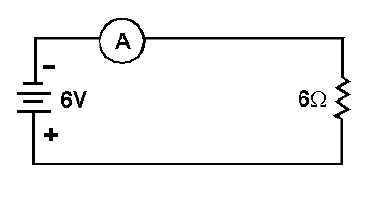1-3
If you intend to accomplish anything in the field of electricity and electronics, you must be aware of
the forces acting inside the circuits with which you work. Modules 1 and 2 of this training series
introduced you to the physics involved in the study of electricity and to the fundamental concepts of
direct and alternating current. The terms voltage (volts), current (amperes), and resistance (ohms) were
explained, as well as the various circuit elements; e.g., resistors, capacitors, inductors, transformers, and
batteries.
In explaining these terms and elements to you, schematic symbols and schematic diagrams were
used. In many of these schematic diagrams, a meter was represented in the circuit, as shown in figure 1-1.
As you recall, the current in a dc circuit with 6 volts across a 6-ohm resistor is 1 ampere. The
@(UPPERCASE A) in figure 1-1 is the symbol for an ammeter. An ammeter is a device that measures
current. The name "ammeter" comes from the fact that it is a meter used to measure current (in amperes),
and thus is called an AMpere METER, or AMMETER. The ammeter in figure 1-1 is measuring a current
of 1 ampere with the voltage and resistance values given.
Figure 1-1.—A simple representative circuit.
In the discussion and explanation of electrical and electronic circuits, the quantities in the circuit
(voltage, current, and resistance) are important. If you can measure the electrical quantities in a circuit, it
is easier to understand what is happening in that circuit. This is especially true when you are
troubleshooting defective circuits. By measuring the voltage, current, capacitance, inductance, impedance,
and resistance in a circuit, you can determine why the circuit is not doing what it is supposed to do. For
instance, you can determine why a radio is not receiving or transmitting, why your automobile will not
start, or why an electric oven is not working. Measurement will also assist you in determining why an
electrical component (resistor, capacitor, inductor) is not doing its job.
The measurement of the electrical parameters quantities in a circuit is an essential part of working on
electrical and electronic equipment.
INTRODUCTION TO CIRCUIT MEASUREMENT
Circuit measurement is used to monitor the operation of an electrical or electronic device, or to
determine the reason a device is not operating properly. Since electricity is invisible, you must use some
sort of device to determine what is happening in an electrical circuit. Various devices called test
equipment are used to measure electrical quantities. The most common types of test equipment use some
kind of metering device.



